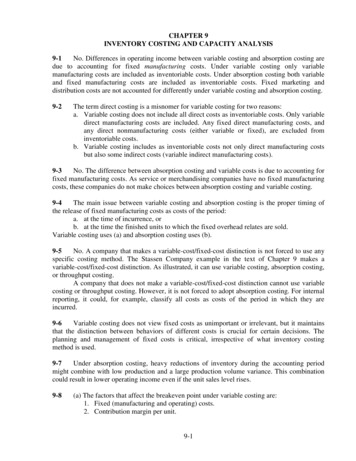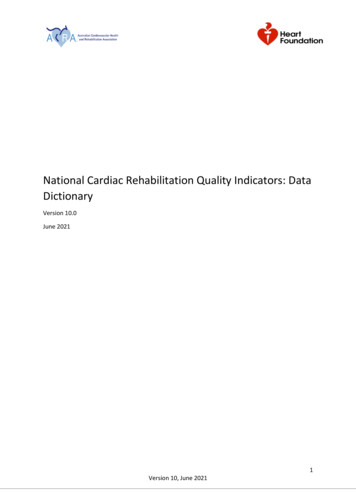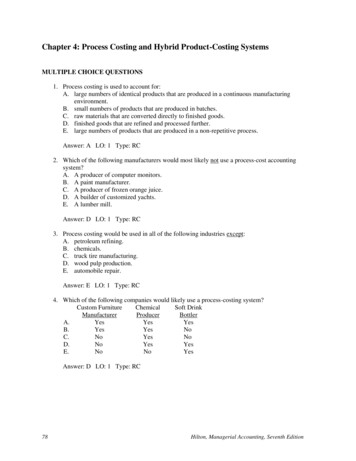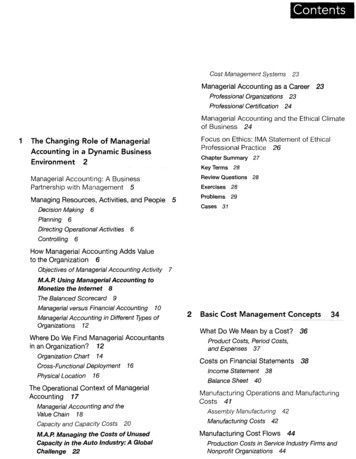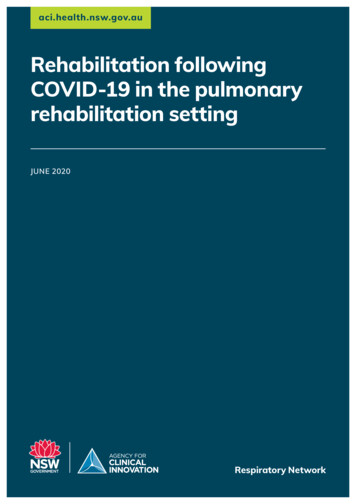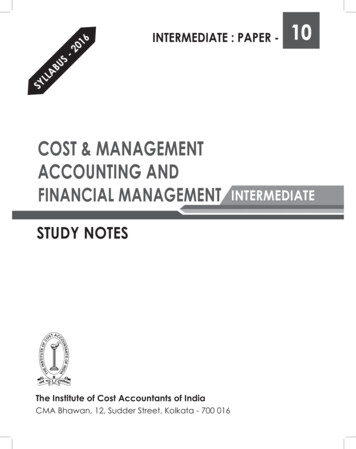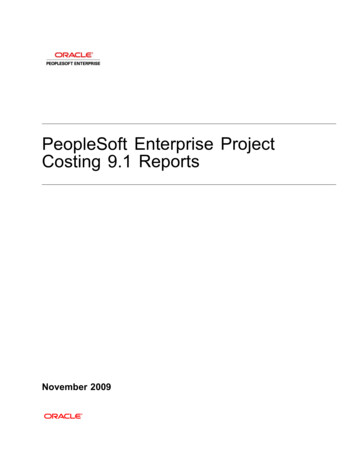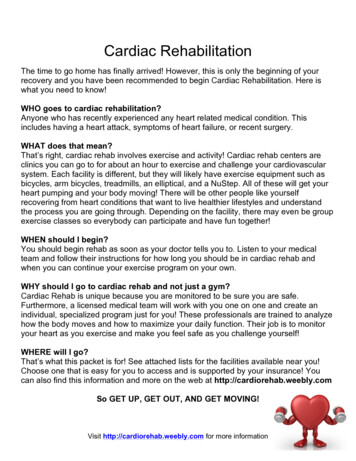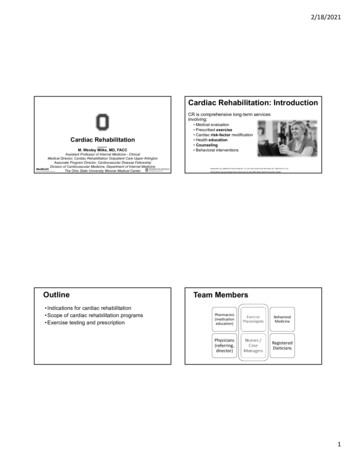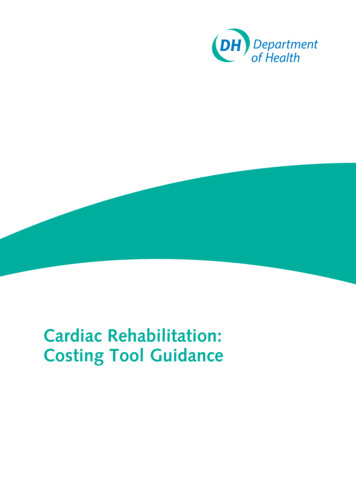
Transcription
Cardiac Rehabilitation: Costing Tool Guidance
DH INFORMATION READER atesCommissioningIM & TFinanceSocial Care / Partnership WorkingDocument purposeBest Practice GuidanceGateway reference14695TitleCardiac Rehabilitation Commissioning PackAuthorStrategic Commissioning Development UnitPublication date15 Oct 2010Target audiencePCT CEs, SHA CEs, GPsCirculation listDescriptionCommissioning Packs are tools to help commissioners improve the quality ofservices for patients and minimise unwarranted variation in service delivery.Each pack provides a tailored set of guidance, templates, tools andinformation to assist commissioners in commissioning healthcare servicesfrom existing providers or for use in new procurements.Cross referenceN/ASuperseded docsN/AAction requiredN/ATimingN/AContact detailsRhiannon WilliamsStrategic Commissioning Development UnitNew King’s Beam House22 Upper GroundSE1 9BWRhiannon.Williams@dh.gsi.gov.ukwww.dh.gov.ukFor recipient’s use
Costing Tool GuidanceCosting Tool Guidance Prepared by the Strategic Commissioning Development Unit (SCDU) 3
Costing Tool GuidanceContents 4Introduction5 1. Pathway Costing5 2. Cost–benefit Analysis7
Costing Tool GuidanceIntroductionThe costing tool has two key functions: Pathway costing – This section of the model provides a means with which tocalculate the total cost for the cardiac rehabilitation pathway on a per-patientbasis. This will help to determine the affordability of local cardiac rehabilitationrequirements and enable the value-for-money evaluation of providers’ quotes. Cost–benefit analysis – The model also enables cost–benefit analysis ofimplementing a cardiac rehabilitation programme, and this can be used in thebusiness case.The Hospital Episode Statistics (HES) data analysis used in the costing tool is currentlyat primary care trust (PCT) level. The costing model and the data analysis will beupdated to reflect the future commissioning architecture.The costing tool includes a full list of assumptions in both the pathway costing andthe cost–benefit analysis sections to highlight the key drivers for the calculations.The costing tool is currently based on the assumption that the cardiacrehabilitation service is centre-based. If the mode of provision is based on anotherdelivery model, such as a home-based model, or based only on the heart manual,commissioners will need to revisit component costs. Evidence indicates thathome-based cardiac rehabilitation is no cheaper than centre-based options.11. Pathway CostingThis section sets out the process that commissioners should follow in determiningthe cost of implementing a cardiac rehabilitation programme. The purpose of themodel is to enable commissioners to determine the affordability of local cardiacrehabilitation requirements and enable the value-for-money evaluation of providers’price quotes.The indicative per-patient cost of 477 calculated in the costing model covers staffcosts only and is based on a series of assumptions that are embedded within thecosting model; additional commissioner costs and set-up costs must be enteredlocally. This model has been completed using the clinical specification in thecommissioning pack and provides example minutes for each step of the pathwayby clinical staff specialism. The example values have been populated based on theconsensus view of the reference group and input from sample providers. They areprovided as a guide and should be modified to reflect the services discussed withproviders and to suit local circumstances.1Taylor R S, Dalal H, Jolly K, Moxham T and Zawada A (2010) Home-based versus centre-based cardiac rehabilitation.Cochrane Database Syst Rev 20(1): CD0071305
Costing Tool GuidanceCommissioners need to understand that the staff cost per patient will be similarto the indicative cost in the model only if their actual local circumstances andcardiac rehabilitation specifications match the assumptions in the model. If localcircumstances and specification requirements differ to any degree, then the staffcost per patient will be different.The costing model represents the activities required to run a generic cardiacrehabilitation programme supporting low to medium-risk patients. Any variation onpatient requirements, such as those falling within a high-risk category (e.g. heartfailure patients), must be considered separately. The cardiac rehabilitationprogramme must be designed in agreement with the providers so that patients’specific needs are adequately met.Key principles that must be adhered to in implementing the cardiac rehabilitationcommissioning pack are as follows: Payment currency – The payment will be due only on patients completing thefull cardiac rehabilitation pathway. Payment trigger – Costs assume that payment will be on completion of thepathway, and require an explicit attrition rate to be agreed between thecommissioners and service providers, as this could have contract managementimplications. Pathway divisibility – The cardiac rehabilitation service elements are defined inthe model. The commissioners, in agreement with their providers, can modifyindividual service elements. Pathway status – The costs assume contracting for cardiac rehabilitation to beon a completed pathway basis. The indicative costs are not mandatory but areevidence based using expected inputs. Pathway variations – The costing is based on specific staff bands, to meetBritish Association of Cardiac Rehabilitation (BACR) minimum standards. Theproviders may have different costs for individual elements but still work withinthe overall pathway costs. Geographical costing differences – The calculated costs are for England andexclude any regional variations; these need to be considered locally, as doother assumptions detailed here. In implementing this cardiac rehabilitationpathway, commissioners may incur additional specific local costs or initialset-up costs, which they must include in their pathway costing, and businesscase exercises. Commissioners will also need to input these additional costs intothe costing model to calculate the full cost reflecting local needs and conditions.6
Costing Tool GuidanceThe following data sources were used in creating the costing model: HES, The Information Centre for Health and Social Care BACR, Standards and Core Components for Cardiac Rehabilitation (2007) Personal Social Services Research Unit NHS Staff Earnings Estimates January 2010, The Information Centre for Healthand Social Care.The costing model includes instructions on how to navigate and complete it for localcosting purposes. The main worksheet tabs to be completed for costing are as follows:1. Staff costing – This tab includes a series of tables that will ultimately calculatethe per-minute cost of each of the range of professions that may be requiredto deliver a cardiac rehabilitation service. Commissioners should review andamend to suit local circumstances the sections headed: a) Staffing allocation;b) Staff assumptions; and c) Minutes calculation.2. Minute calculator – Commissioners are required to enter their assumptionsand activity inputs showing how the cardiac rehabilitation service will bedelivered. The model is completed with indicative assumptions and activities,which the commissioners must amend as appropriate to reflect local needs.3. Summary costing – The costing model is set up to calculate the staff costsonly. All other commissioner-specific and initial set-up costs need to becompleted by the commissioners in the ‘Summary costing’ tab. Example costtypes are listed in this tab, but commissioners are advised to amend or inputtheir cost categories as appropriate.2. Cost–benefit AnalysisThe cost–benefit analysis compares the total current costs of acute admission andcurrent cardiac rehabilitation costs with the total potential costs after implementingthe proposed cardiac rehabilitation commissioning pack, thus demonstrating thepotential financial impact. The anticipated re-admission reductions are the keydrivers in this cost–benefit analysis.The re-admission analysis and average cost of acute admissions have been derived from: 2008/9 HES data 2010/11 tariff prices 2007/8 reference cost activities.The source data will be updated as more up-to-date data become available.7
Costing Tool GuidanceWhen using the cost–benefit section of the tool, commissioners should completeentries for the following assumptions to reflect their local circumstances:1. Selecting your PCT – Commissioners should select their PCT in the ‘Costbenefit input’ tab, or create a PCT consortium. This can be done by clicking onthe pull-down list. This will drive the calculations for PCT patient populationnumbers, which in turn will drive much of the cost–benefit calculations and thecharts in the model. Where commissioners have chosen to work within a PCTconsortium, they can then choose the PCTs to include in the consortium byfollowing the instructions in the ‘PCT consortium’ tab.2. Selecting national or strategic health authority (SHA) view – By choosingeither a national or an SHA view, commissioners will be able to compare theirposition against either national or SHA averages.3. Current cost of cardiac rehabilitation – If a cardiac rehabilitation programmeexists, the current costs of running the programme need to be entered in themodel. For demonstration purposes only, the model assumes 50,000 per yearper PCT. This must be changed to reflect the actual local cost.4. Estimated percentage of patient take-up – Commissioners must input thepercentage of in-scope patients it is assumed would take part in the cardiacrehabilitation services. For demonstration purposes only, 50% of patientsdiagnosed as in-scope are assumed to take part in cardiac rehabilitation in thefuture. Commissioners must input their assumed percentage into the model.5. Target acute re-admissions – Commissioners must input what they wish theirtarget re-admission level to be as a result of implementing the cardiacrehabilitation programme. The entry must be the target re-admission rates,not the percentage reduction. For example, if the existing re-admission ratefor the in-scope cohort of patients is 25%, and the goal is to reduce this to15%, then 15% must be entered into the appropriate cell in the model.For demonstration purposes only, the target re-admission rate is assumed tobe 15%. This must be changed to reflect commissioner goals.8
Crown copyright 2010401779/Cardiac Rehabilitation: Costing Tool GuidanceAugust 10Produced by COI for the Department of Health
cardiac rehabilitation specifications match the assumptions in the model. If local circumstances and specification requirements differ to any degree, then the staff cost per patient will be different. The costing model represents the activities required to run a generic cardiac rehabilitation programme supporting low to medium-risk patients.
